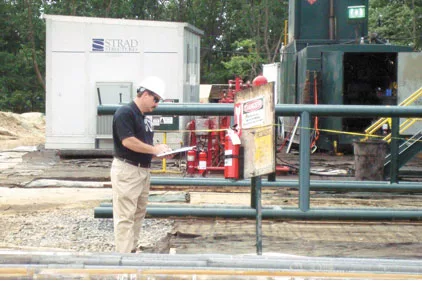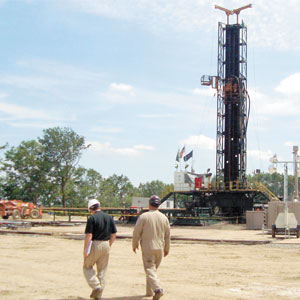Tips Help Drillers Stay Incident-Free in the Field This Summer


|
| It's critical for on-site supervisors to know safety guidelines, set the expectation those guidelines will be followed, and to train employees on proper procedures. Source: Lancaster Safety Consulting Inc. |
“These things can happen in the blink of an eye,” says Galloway. She talks about a worker she treated one summer who tried to use a screwdriver to dislodge a nut, which was stuck. The screwdriver flew back and struck him in his eye. He wasn’t wearing protective eyewear.
“I had to remove his eye. That was a 100 percent preventable incident,” she says, adding that the man was lucky to walk away with his life.
With summer in full swing, crews should set aside time to brush up on field safety, paying special attention to seasonal hazards. National Driller talked to three industry experts to get their take on how to minimize incidents and injuries in the field this summer.
Common Summer Hazards
| FIELD GUIDE TO SUMMER HAZARDS |
|
POISON IVY Where it’s found: Throughout the U.S., often in recently cleared areas How to identify: 3 mitt-shaped leaves, usually with red where leaves meet POISON OAK Where it’s found: Primarily the Southeast and West Coast How to identify: 3 oak-shaped leaves, sometimes with pale green-yellow flowers and/or berries POISON SUMAC Where it’s found: East of and along the Mississippi River, typically in boggy areas How to identify: Woody shrub with stems containing 7-13 leaves arranged in pairs, sometimes with pale berries BLACK WIDOW SPIDER Where it’s found: Entire U.S., most commonly in southern and western regions. How to identify: Red markings on abdomen BROWN RECLUSE SPIDER Where it’s found: Most commonly in midwestern and southern states How to identify: Brown with violin-shaped marking on head HOBO SPIDER Where it’s found: Pacific Northwest How to identify: Large and brown with yellow pattern on abdomen and distinct lack of dark banding on legs RATTLESNAKE Where it’s found: Entire U.S. How to identify: Striped with rattle on tail and triangle-shaped head. Poisonous snakes can often be identified by their triangle head shape owing to venom sacs on each side of the head. COPPERHEAD SNAKE Where it’s found: Eastern U.S. and west into Texas How to identify: Reddish or golden tan color, with hourglass-shaped bands. WATER MOCCASIN OR COTTONMOUTH SNAKE Where it’s found: Wetlands and water sources in the southeastern U.S. How to identify: Dark coloring and possible banding (juveniles have bold orange and brown bands with a yellow tail), with a distinctive white mouth. CORAL SNAKE Where it’s found: Southern U.S. How to identify: Red and yellow bands that touch (unlike the king snake, which has red and yellow bands that don’t touch) |
Not surprisingly, heat-related illnesses are some of the most common Galloway encounters. It’s because heat exhaustion and heat stroke escalate fast when workers ignore the warning signs.
“As soon as somebody is sweating, or dry and flushed, not feeling well, maybe a bit of a headache or they’re feeling slightly nauseous — that’s all the start of it,” she says. “If you’re feeling bad in the heat, you’re on your way to developing heat stroke.”
At this point, it’s crucial to get inside, drink water and cool off to prevent your internal body temperature from rising even further. Left untreated, heat stroke can quickly turn fatal. If someone shows signs of confusion, loss of consciousness or seizures, call 911 and get medical help immediately.
The good news is, preventing heat-related illness is as simple as drinking lots of water and taking regular breaks in the shade. Working hard in the heat while wearing bulky personal protective equipment is a recipe for heat stroke. A risk made worse, Galloway points out, by consuming energy drinks.
“They’re actually very dehydrating,” she says. “Some of the molecules in these drinks are very hard for the kidneys to process, making it easier become dehydrated.”
Galloway says supervisors must take the lead in preventing heat-related illnesses by being aware of the symptoms, and by making sure crews drink plenty of fresh water and take shade breaks.
While heat is an ongoing threat, other environmental hazards also pose serious risks to worksite safety. Severe weather, including lightning and tornadoes, is one huge concern for crews working in open areas.
“If a summer storm does sneak up, where do you go? What do you do?” asks Galloway, highlighting the need for continuous safety planning on the part of site supervisors.
Galloway recommends breaking down hazard assessments by season, making plans for dealing with threats posed by local wildlife. Knowing how to use an EpiPen, for instance, can save a worker’s life if a bee or wasp sting leads to a life-threatening allergic reaction. Poisonous snakes, spiders and ticks should also be part of hazard analysis.
“Do you do a sweep for rattlesnakes? Do you know what to do if someone gets bit by a rattlesnake?” asks Galloway. “Look at different things that are unique to your area, and make them part of your seasonal ERP [emergency response plan].”
Failing to Plan = Planning to Fail
Britt Howard, director of Health, Safety and Environmental for CH2M Hill’s Oil, Gas and Chemical division, also emphasizes the importance of planning for safety. CH2M Hill’s HSE (health, safety and environment) management system focuses heavily on the Plan-Do-Check-Act method for performing more effective work.
“If you establish a fantastic safe work plan, the rest is relatively easy,” Howard says. He points out that while this concept is already widely embraced by many companies, others with fewer resources and less experience have been slower to adopt it.
“Planning for twenty minutes at the beginning of the day will pay great dividends for safety performance, but also for operations and quality. Safety feeds into a lot of other disciplines,” he says.
While hand injuries are one of Howard’s top concerns from a routine injury perspective, he says severe injuries are more likely to happen when mobilizing or demobilizing heavy equipment. Pressure to save time due to high drilling costs — whether from leadership or crews themselves — can cause workers to lose focus, just when it’s needed most.
“A lot of injuries happen before the permit is generated or after the permit has expired,” says Howard, comparing it to the experience of driving home as if on autopilot. He says maintaining situational awareness is key to preventing accidents during this critical period.
Ultimately, Howard says, the front line supervisor drives safety performance by setting expectations of how work is performed.
“If safe work is not a part of those expectation-setting conversations, you’re going to have challenges and issues,” Howard says.
He also stresses the importance of front line supervisors cultivating genuine relationships with crew members. Not only does this boost effectiveness, it also promotes safety.
“They’re the most important piece,” Howard says, referring to the front line supervisor. “They are in the field, they have that relationship. They know what Britt’s like, day in and day out, when he’s distracted because his son’s in the hospital,” he says.
Another critical element of any safety program is stop work authority. Supervisors must create an environment where people understand they have both the right and the authority to stop work when they see unsafe conditions.
“It’s not to call someone out or get anyone in trouble. It’s totally based upon wanting everyone to go home safely,” says Howard, comparing it to the Department of Homeland Security’s famous slogan, “If you see something, say something.”
Your Business at Stake
For Jeffrey Lancaster, founder of Lancaster Safety Consulting Inc., the biggest risks he sees workers taking involve falls.
“Too often, employees that are athletic think nothing about flying up a ladder or machinery,” Lancaster says, adding that any work performed above 4 feet requires fall prevention or protection. The standard is 6 feet for construction, but oil and gas drilling falls under OSHA’s general industry standards.
When company leaders fail to make safety a priority, they’re not just putting lives at risk. They’re also gambling their business, risking regulatory actions that can deal a harsh blow to a company’s bottom line.
OSHA violations carry stiff fines and penalties, including the following:
- Up to $7,000 per incident for serious violations, with repeat fines of up to $70,000.
- Penalties for willful violations of up to $250,000 per citation.
- Six months of jail time and/or up to $10,000 for willful violations leading to death.
Lancaster, whose company specializes in OSHA compliance, points to OSHA’s general duty clause requiring employers to provide a workplace free of known hazards.
“Setting up a drill site means assessing the workplace for all hazards, starting with accessibility to the site,” Lancaster says. Employers must also develop a written, site-specific safety plan for each applicable OSHA standard and provide frequent, periodic training for workers, especially those onsite for the first time. Field supervisors must consider the native language of their workers.
“Not everyone these days speaks English,” says Lancaster. “The employer has a duty to make sure all workers understand and will agree to abide.”
Drilling operations often involve multiple crews, all of which may treat safety differently. The fact that field supervisors are required to be familiar with OSHA’s multiemployer worksite policy doesn’t mean everything will run smoothly.
“Managing subcontractors is always a concern,” Lancaster says. “Do the subs have adequate safety programs and training? Have they trained their new hires adequately? Is the training site-specific to the hazards that could be encountered? These are the questions that need to be answered.”
Lancaster says the trend in recent years toward subcontractor prequalification has helped improve safety performance.
“More of our clients are being asked to submit written programs ahead of time to prove their commitment to safety,” says Lancaster. “That’s a step in the right direction.”
Looking for a reprint of this article?
From high-res PDFs to custom plaques, order your copy today!









